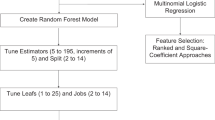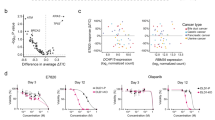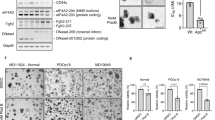Abstract
Pre-mRNA alternative splicing (AS) is a crucial process, which plays a significant role in inducing tumor subtype-specific alterations and the hallmark of epigenetic heterogeneity in tumorigenesis. However, the regulatory mechanisms of pre-mRNA AS remain obscure. This study demonstrates that splicing factor RBM5 recruits long non-coding RNA MGC32805, and they act in concert as oncogenes in colorectal cancer (CRC) cells by preventing apoptosis, as well as promoting migration and resistance to 5-Fluorouracil (5-FU). Specifically, they promote the exclusion of exon 6 in the FAS pre-mRNA, leading to decreased expression of mFAS (an apoptotic isoform) and increased expression of ΔFAS (an anti-apoptotic isoform) in both CRC cells and a mouse xenograft model. RBM5, which contains Leu650 and Arg681 residues in the ZnF-C2H2 domain, recognizes the “GUACG” (−1299 to −1303) motif in MGC32805. Furthermore, MGC32805 blocks the binding site (Lys645) of the E3 ubiquitin ligase PRPF19, which targets RBM5 for degradation, thus increasing the stability of RBM5. The His665 and Leu668 residues of RBM5 specifically bind to the FAS exon 6 adjacent element (GAACAAA), which drives FAS-AS events and increases the expression ratio of the ΔFAS/mFAS isoforms. These findings introduce a novel research strategy to investigate the epigenetic heterogeneity and plasticity of tumorigenesis. They also shed light on the mechanism of MGC32805-mediated transformation of the FAS tumor neoantigen function from a tumor suppressor to an oncogene at the AS level through its interactions with RBM5.
This is a preview of subscription content, access via your institution
Access options
Subscribe to this journal
Receive 50 print issues and online access
$259.00 per year
only $5.18 per issue
Buy this article
- Purchase on SpringerLink
- Instant access to full article PDF
Prices may be subject to local taxes which are calculated during checkout








Similar content being viewed by others
Data availability
The authors declare that all the data supporting the findings in this study are available in this study and its Supplementary materials, or are available from the corresponding author through reasonable request.
References
Cieply B, Carstens RP. Functional roles of alternative splicing factors in human disease. Wiley Interdiscip Rev RNA. 2015;6:311–26.
Sterne-Weiler T, Weatheritt RJ, Best AJ, Ha KC, Blencowe BJ. Efficient and Accurate Quantitative Profiling of Alternative Splicing Patterns of Any Complexity on a Laptop. Mol Cell. 2018;72:187–200.e6.
Zhang X, Ameer FS, Azhar G, Wei JY. Alternative Splicing Increases Sirtuin Gene Family Diversity and Modulates Their Subcellular Localization and Function. Int J Mol Sci. 2021;22:473.
Jiang W, Chen L. Alternative splicing: Human disease and quantitative analysis from high-throughput sequencing. Comput Struct Biotechnol J. 2020;19:183–95.
Bonnal SC, Lopez-Oreja I, Valcarcel J. Roles and mechanisms of alternative splicing in cancer - implications for care. Nat Rev Clin Oncol. 2020;17:457–74.
Lu SX, De Neef E, Thomas JD, Sabio E, Rousseau B, Gigoux M, et al. Pharmacologic modulation of RNA splicing enhances anti-tumor immunity. Cell. 2021;184:4032–47.e31.
Stanley RF, Abdel-Wahab O. Dysregulation and therapeutic targeting of RNA splicing in cancer. Nat Cancer. 2022;3:536–46.
Zhang Y, Qian J, Gu C, Yang Y. Alternative splicing and cancer: a systematic review. Signal Transduct Target Ther. 2021;6:78.
Ramesh P, Lannagan TR, Jackstadt R, Atencia Taboada L, Lansu N, Wirapati P, et al. BCL-XL is crucial for progression through the adenoma-to-carcinoma sequence of colorectal cancer. Cell Death Differ. 2021;28:3282–96.
Watanabe J, Kushihata F, Honda K, Sugita A, Tateishi N, Mominoki K, et al. Prognostic significance of Bcl-xL in human hepatocellular carcinoma. Surgery. 2004;135:604–12.
Karczmarek-Borowska B, Filip A, Wojcierowski J, Smolen A, Korobowicz E, Korszen-Pilecka I, et al. Estimation of prognostic value of Bcl-xL gene expression in non-small cell lung cancer. Lung Cancer. 2006;51:61–9.
Marone M, Scambia G, Mozzetti S, Ferrandina G, Iacovella S, De Pasqua A, et al. bcl-2, bax, bcl-XL, and bcl-XS expression in normal and neoplastic ovarian tissues. Clin Cancer Res. 1998;4:517–24.
De Blasio A, Vento R, Di Fiore R. Mcl-1 targeting could be an intriguing perspective to cure cancer. J Cell Physiol. 2018;233:8482–98.
Wang H, Guo M, Wei H, Chen Y. Targeting MCL-1 in cancer: current status and perspectives. J Hematol Oncol. 2021;14:67.
Cheng J, Zhou T, Liu C, Shapiro JP, Brauer MJ, Kiefer MC, et al. Protection from Fas-mediated apoptosis by a soluble form of the Fas molecule. Science. 1994;263:1759–62.
Huertas CS, Carrascosa LG, Bonnal S, Valcarcel J, Lechuga LM. Quantitative evaluation of alternatively spliced mRNA isoforms by label-free real-time plasmonic sensing. Biosens Bioelectron. 2016;78:118–25.
Du J, Luo Y, Zhang S, Wang B, Chen C, Zhu G, et al. Splicing factor SRSF1 promotes breast cancer progression via oncogenic splice switching of PTPMT1. J Exp Clin Cancer Res. 2021;40:171.
Chen D, Zhao Z, Chen L, Li Q, Zou J, Liu S. PPM1G promotes the progression of hepatocellular carcinoma via phosphorylation regulation of alternative splicing protein SRSF3. Cell Death Dis. 2021;12:722.
Han P, Cao P, Yue J, Kong K, Hu S, Deng Y, et al. Knockdown of hnRNPA1 Promotes NSCLC Metastasis and EMT by Regulating Alternative Splicing of LAS1L exon 9. Front Oncol. 2022;12:837248.
Hamdollah Zadeh MA, Amin EM, Hoareau-Aveilla C, Domingo E, Symonds KE, Ye X, et al. Alternative splicing of TIA-1 in human colon cancer regulates VEGF isoform expression, angiogenesis, tumour growth and bevacizumab resistance. Mol Oncol. 2015;9:167–78.
Gonzalez I, Munita R, Agirre E, Dittmer TA, Gysling K, Misteli T, et al. A lncRNA regulates alternative splicing via establishment of a splicing-specific chromatin signature. Nat Struct Mol Biol. 2015;22:370–6.
Khan MR, Wellinger RJ, Laurent B. Exploring the Alternative Splicing of Long Noncoding RNAs. Trends Genet. 2021;37:695–8.
Yadav B, Yadav P, Yadav S, Pandey AK. Role of long noncoding RNAs in the regulation of alternative splicing in glioblastoma. Drug Discov Today. 2024;29:104140.
Ouyang J, Zhong Y, Zhang Y, Yang L, Wu P, Hou X, et al. Long non-coding RNAs are involved in alternative splicing and promote cancer progression. Br J Cancer. 2022;126:1113–24.
Singh R, Gupta SC, Peng WX, Zhou N, Pochampally R, Atfi A, et al. Regulation of alternative splicing of Bcl-x by BC200 contributes to breast cancer pathogenesis. Cell Death Dis. 2016;7:e2262.
Redis RS, Vela LE, Lu W, Ferreira de Oliveira J, Ivan C, Rodriguez-Aguayo C, et al. Allele-Specific Reprogramming of Cancer Metabolism by the Long Non-coding RNA CCAT2. Mol Cell. 2016;61:520–34.
Inoue A, Yamamoto N, Kimura M, Nishio K, Yamane H, Nakajima K. RBM10 regulates alternative splicing. FEBS Lett. 2014;588:942–7.
Kotlajich MV, Hertel KJ. Death by splicing: tumor suppressor RBM5 freezes splice-site pairing. Mol Cell. 2008;32:162–4.
Mickleburgh I, Kafasla P, Cherny D, Llorian M, Curry S, Jackson RJ, et al. The organization of RNA contacts by PTB for regulation of FAS splicing. Nucleic Acids Res. 2014;42:8605–20.
Wu H, Qin W, Lu S, Wang X, Zhang J, Sun T, et al. Long noncoding RNA ZFAS1 promoting small nucleolar RNA-mediated 2’-O-methylation via NOP58 recruitment in colorectal cancer. Mol Cancer. 2020;19:95.
Lu S, Han L, Hu X, Sun T, Xu D, Li Y, et al. N6-methyladenosine reader IMP2 stabilizes the ZFAS1/OLA1 axis and activates the Warburg effect: implication in colorectal cancer. J Hematol Oncol. 2021;14:188.
Julien P, Minana B, Baeza-Centurion P, Valcarcel J, Lehner B. The complete local genotype-phenotype landscape for the alternative splicing of a human exon. Nat Commun. 2016;7:11558.
Nakajima T, Ichii S, Furuyama J, Tamaoki T, Hashimoto T. A new alternative splice variant of the mouse Fas antigen with a deletion in the N-terminal portion of the extracellular domain. Life Sci. 1996;58:761–8.
Papoff G, Cascino I, Eramo A, Starace G, Lynch DH, Ruberti G. An N-terminal domain shared by Fas/Apo-1 (CD95) soluble variants prevents cell death in vitro. J Immunol. 1996;156:4622–30.
Sharma S, Carmona A, Skowronek A, Yu F, Collins MO, Naik S, et al. Apoptotic signalling targets the post-endocytic sorting machinery of the death receptor Fas/CD95. Nat Commun. 2019;10:3105.
Chen M, Manley JL. Mechanisms of alternative splicing regulation: insights from molecular and genomics approaches. Nat Rev Mol Cell Biol. 2009;10:741–54.
Tripathi V, Ellis JD, Shen Z, Song DY, Pan Q, Watt AT, et al. The nuclear-retained noncoding RNA MALAT1 regulates alternative splicing by modulating SR splicing factor phosphorylation. Mol Cell. 2010;39:925–38.
Zhang Y, Fang Y, Ma L, Xu J, Lv C, Deng L, et al. LINC00857 regulated by ZNF460 enhances the expression of CLDN12 by sponging miR-150-5p and recruiting SRSF1 for alternative splicing to promote epithelial-mesenchymal transformation of pancreatic adenocarcinoma cells. RNA Biol. 2022;19:548–59.
Zhu LY, Zhu YR, Dai DJ, Wang X, Jin HC. Epigenetic regulation of alternative splicing. Am J Cancer Res. 2018;8:2346–58.
He S, Shi J, Zhou H, Li Q, Wu L. Lnc-ABCA12-8 confers acquired resistance to gefitinib in non-small cell lung cancer by regulating the alternative splicing of fibronectin 1 in the IIICS region. Cancer Gene Ther. 2022;29:1686–96.
Liu M, Zhang S, Zhou H, Hu X, Li J, Fu B, et al. The interplay between non-coding RNAs and alternative splicing: from regulatory mechanism to therapeutic implications in cancer. Theranostics. 2023;13:2616–31.
Du JX, Zhu GQ, Cai JL, Wang B, Luo YH, Chen C, et al. Splicing factors: Insights into their regulatory network in alternative splicing in cancer. Cancer Lett. 2021;501:83–104.
Sutherland LC, Wang K, Robinson AG. RBM5 as a putative tumor suppressor gene for lung cancer. J Thorac Oncol. 2010;5:294–8.
Rintala-Maki ND, Goard CA, Langdon CE, Wall VE, Traulsen KE, Morin CD, et al. Expression of RBM5-related factors in primary breast tissue. J Cell Biochem. 2007;100:1440–58.
Bradley RK, Anczukow O. RNA splicing dysregulation and the hallmarks of cancer. Nat Rev Cancer. 2023;23:135–55.
Wang E, Aifantis I. RNA Splicing and Cancer. Trends Cancer. 2020;6:631–44.
Zhang L, Zhang Q, Yang Y, Wu C. The RNA recognition motif domains of RBM5 are required for RNA binding and cancer cell proliferation inhibition. Biochem Biophys Res Commun. 2014;444:445–50.
Serrano P, Hammond JA, Geralt M, Wuthrich K. Splicing Site Recognition by Synergy of Three Domains in Splicing Factor RBM10. Biochemistry. 2018;57:1563–7.
Chang J, Zhang Y, Zhou T, Qiao Q, Shan J, Chen Y, et al. RBM10 C761Y mutation induced oncogenic ASPM isoforms and regulated β-catenin signaling in cholangiocarcinoma. J Exp Clin Cancer Res. 2024;43:104.
Corsini L, Bonnal S, Basquin J, Hothorn M, Scheffzek K, Valcarcel J, et al. U2AF-homology motif interactions are required for alternative splicing regulation by SPF45. Nat Struct Mol Biol. 2007;14:620–9.
Acknowledgements
We gratefully appreciate the efforts and contributions of doctors, and technical staff at the First Hospital of China Medical University. We thanks Shanghai OE Biotech Technology Co, Ltd. for microarray sequencing service and bioinformatics support. This work was supported by grants from the National Natural Science Foundation of China (82272915, 82073884), China Postdoctoral Science Foundation (2023MD734246), the project of the fourth batch of science and technology plan of Liaoning province (2021JH210300133), science and technology innovation team project of China Medical University (CXTD2022007), supporting the high-quality development of science and technology funding projects at China Medical University (2022011963-JH2/202), Liaoning Province Central Guide Local Science and Technology Development Fund (2024JH6/100800003), and Beijing CSCO Clinical Oncology Research Foundation (Y-Gilead2024-PT-0201).
Author information
Authors and Affiliations
Contributions
MW, KL, and HW conceived and designed the project; XH, YW, XZ, QZ, YZ, WC, and MZ performed experiments and/or data acquisition and analyses; MW, KL, HW, XH, and HZ contributed technical/reagents materials, analytic tools and/or grant support; MW, HW, and XH prepared, wrote, and/or revision the manuscript. All authors discussed the results and commented on the manuscript.
Corresponding authors
Ethics declarations
Competing interests
The authors declare no competing interests.
Consent for publication
All of the authors have written informed consent.
Additional information
Publisher’s note Springer Nature remains neutral with regard to jurisdictional claims in published maps and institutional affiliations.
Supplementary information
Rights and permissions
Springer Nature or its licensor (e.g. a society or other partner) holds exclusive rights to this article under a publishing agreement with the author(s) or other rightsholder(s); author self-archiving of the accepted manuscript version of this article is solely governed by the terms of such publishing agreement and applicable law.
About this article
Cite this article
Wu, H., Hu, X., Wang, Y. et al. RBM5 recruiting MGC32805 in a sandwich mode and inducing ΔFAS neoantigen and triggering FAS properties switch: implication in colorectal cancer. Oncogene 44, 3052–3069 (2025). https://doi.org/10.1038/s41388-025-03390-4
Received:
Revised:
Accepted:
Published:
Issue date:
DOI: https://doi.org/10.1038/s41388-025-03390-4



